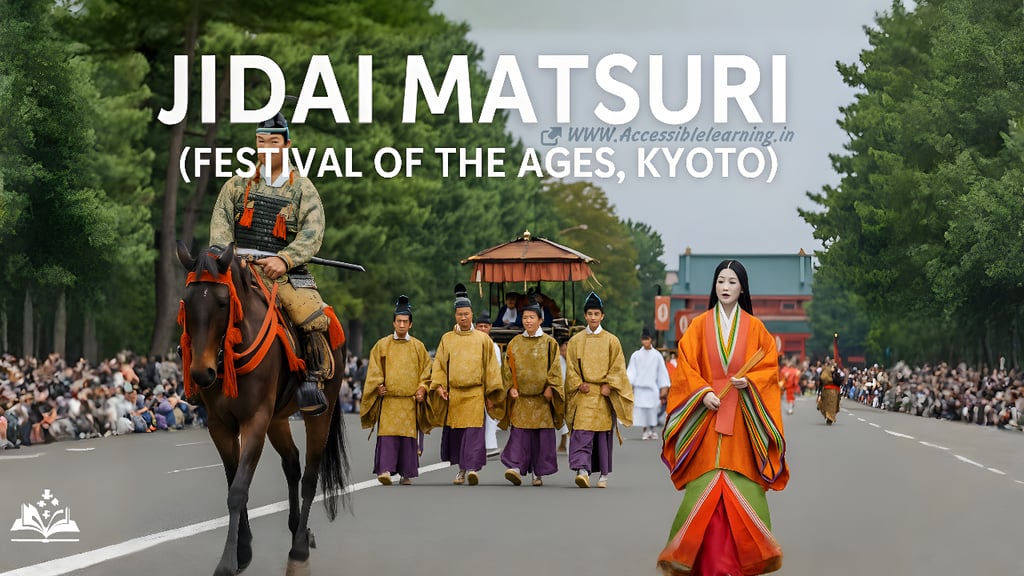
Jidai Matsuri (Festival of the Ages, Kyoto): History, Parade, and Travel Guide
Explore Kyoto’s Jidai Matsuri, the Festival of the Ages, held every October 22. Learn its history, parade route, costumes, best viewing spots, travel tips, and why it’s one of Kyoto’s most iconic traditions.
CULTURE/TRADITIONEVENT/SPECIALJAPANCELEBRATION/FESTIVALS
Kim Shin
10/15/20253 min read


Every October, Kyoto transforms into a living timeline during Jidai Matsuri (時代祭) — the Festival of the Ages. Unlike most festivals centered on one period or deity, Jidai Matsuri celebrates the entire history of Kyoto, Japan’s ancient capital for over a thousand years. With a grand parade of 2,000 participants in meticulously recreated costumes, it feels as if Kyoto’s streets have opened a portal into the past.
This is not just a parade; it’s a cultural time machine, showcasing Japan’s journey from the Heian era to the Meiji Restoration.
Festival Overview
Date: October 22 every year (postponed only in case of bad weather).
Route: Starts from Kyoto Imperial Palace (Kenreimon-mae) at noon and ends at Heian Jingu Shrine around 2:30 pm.
Distance: Approximately 4.6–5 km.
Participants: About 2,000 people, plus horses, ox-drawn carriages, and musicians.
Duration: It takes nearly two hours for the entire procession to pass any given spot.
Entry: Free to watch from sidewalks, with optional paid seating for reserved views.
Historical Background
The Jidai Matsuri was first held in 1895 to celebrate the 1,100th anniversary of Heian-kyō (Kyoto’s founding in 794) and to honor Emperor Kanmu, who established the city as Japan’s capital. At the same time, Heian Jingu Shrine was built to enshrine the spirit of the emperor.
Since then, the festival has become one of Kyoto’s Three Great Festivals, alongside Gion Matsuri (July) and Aoi Matsuri (May).
The Parade: A Walk Through Time
The highlight of Jidai Matsuri is its grand procession. Unlike typical festivals where floats dominate, this one is about people, costumes, and history. The parade moves in chronological order, starting with the Meiji period (19th century) and going backward through time to the Heian era.
Here’s what you’ll see:
Meiji Restoration Figures — Imperial envoys, samurai reformists, and scholars.
Edo Period (1603–1868) — Merchants, townspeople, samurai, and cultural icons.
Sengoku & Muromachi Periods (14th–16th centuries) — Armored warriors, military leaders, and banner carriers.
Kamakura & Fujiwara Eras — Courtiers, monks, and early samurai.
Heian Period (794–1185) — Aristocrats in flowing robes, elegant noblewomen in junihitoe (12-layered kimono), and ox-drawn carriages.
Each group is accompanied by music, horses, and ceremonial items, making the parade a living museum of Japanese history.
Costumes and Authenticity
What makes Jidai Matsuri so remarkable is the attention to detail.
Costumes are faithful reproductions based on historical texts, artwork, and museum references.
Samurai armor, court robes, and peasant outfits are all hand-crafted by artisans.
Even accessories like swords, fans, and hats are authentically reproduced.
The result is a spectacular visual journey, with colors, fabrics, and designs that transport you centuries back in time.
Best Places to Watch
If you’re planning to see Jidai Matsuri, location matters.
Kyoto Imperial Palace (Start Point): Best for watching rituals and the beginning of the parade.
Oike Street (Karasuma Oike area): Official paid seating available here. Great for photography with open spaces.
Kawaramachi & Sanjo: Lively areas with traditional Kyoto atmosphere.
Heian Jingu Shrine (End Point): Perfect for close-up views of participants and final ceremonies.
👉 Tip: Arrive at least an hour early to secure a good spot. Paid seating guarantees comfort and unobstructed views.
Travel & Practical Tips
Getting There:
Imperial Palace: Nearest stations are Imadegawa or Marutamachi (Kyoto Subway Karasuma Line).
Heian Jingu Shrine: Use Higashiyama Station (Tozai Line) or Sanjo Keihan Station.
Weather: The festival happens rain or shine, but it may be postponed to the next day in case of heavy rain.
Crowds: Compared to Gion Matsuri, Jidai Matsuri is calmer, but sidewalks still fill quickly.
Accessibility: Sidewalks are mostly flat, but crowds may limit mobility. Paid seating is better for wheelchair users.
Family-Friendly: Children enjoy the costumes; bring snacks and plan breaks since the parade lasts over 2 hours.
Photography Tips
Lenses: A medium zoom (70–200mm) captures portraits and costume details; a wide-angle lens works for group shots.
Light: October sunlight in Kyoto is soft, but shadows from buildings can affect shots — use faster shutter speeds for moving subjects.
Etiquette: Many participants will happily pose at Heian Jingu after the parade, but always ask politely.
FAQs
Q: When is Jidai Matsuri held?
October 22 every year (postponed to Oct 23 in case of rain).
Q: How long is the parade?
Around 4.6–5 km, lasting about 2 hours at each viewing point.
Q: Is it free to watch?
Yes, but paid seating offers the best views.
Q: What makes it different from Gion Matsuri?
While Gion focuses on giant floats, Jidai Matsuri is about historical costumes and people.
Q: Can I take photos?
Absolutely, but be respectful and ask before close-up portraits.
Jidai Matsuri is not just a festival—it’s Kyoto’s gift to history lovers. Whether you’re fascinated by Japan’s samurai past, enchanted by Heian court elegance, or simply looking for a unique cultural experience, this festival delivers it all.
If you’re visiting Kyoto in October, make Jidai Matsuri a highlight of your trip — it’s a celebration where 1,100 years of history walk right past you.
Subscribe to our newsletter
All © Copyright reserved by Accessible-Learning
| Terms & Conditions
Knowledge is power. Learn with Us. 📚


